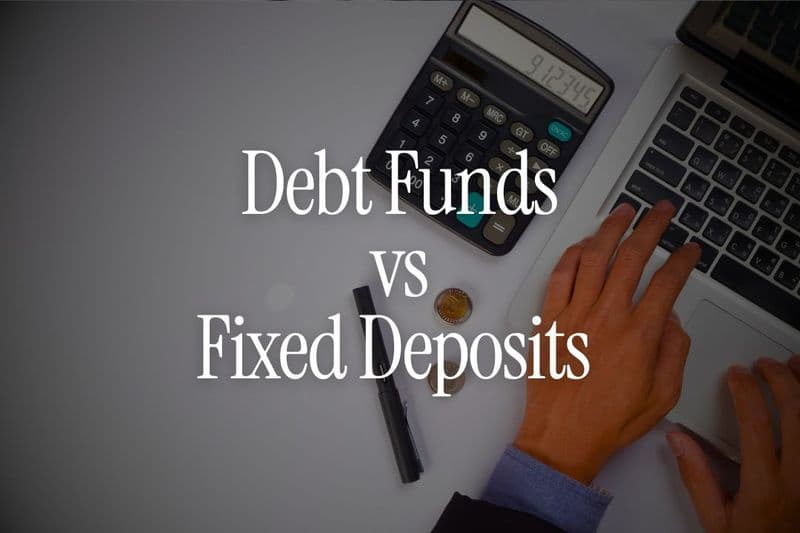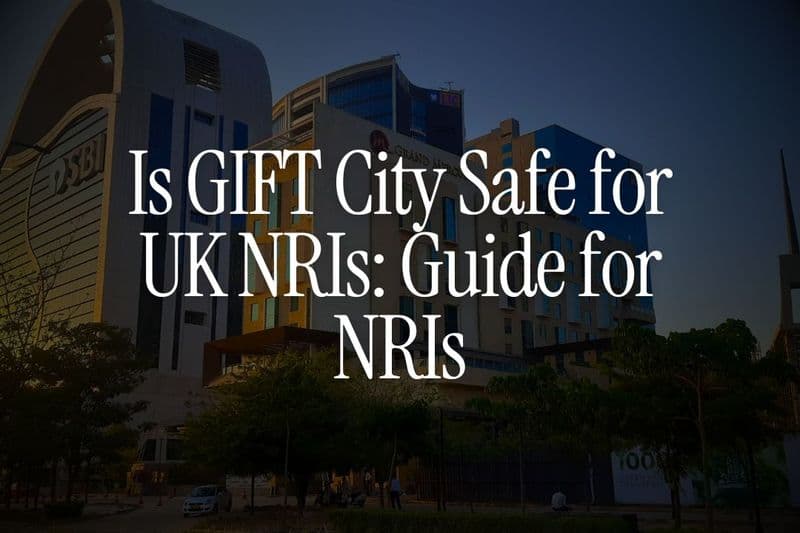
You're sitting in Dubai, planning to visit India next year. You have AED 50,000 saved up. Should you park it in a debt fund or go for a fixed deposit?
We face this question almost daily from NRIs who want their money to work harder than a savings account but need access within 6-12 months. The answer isn't straightforward – it depends on your tax status, country of residence, and how quickly you might need the money.
After helping thousands of NRIs navigate this decision, we have noticed most make one critical mistake: they compare only interest rates. But for short-term goals, that's just one piece of the puzzle.
Understanding Your Options as an NRI
When investing for short-term goals (3-12 months), you have three primary fixed-income choices:
- Traditional NRE/NRO Fixed Deposits – The familiar option most NRIs choose
- Debt Mutual Funds – Market-linked but relatively stable
- GIFT City USD Fixed Deposits – A newer option many NRIs don't know about
Each serves different needs. Let us break down what matters most for your short-term money.
Also Read - Taxation on Mutual Funds
The Returns Game: It's Not What You Earn, It's What You Keep
Fixed Deposit Returns
Current NRE FD rates range from 6.5% to 7.5% annually. Sounds good until you factor in:
- Currency depreciation (INR has depreciated ~3-4% annually against USD)
- Potential TDS for NRO deposits
- Lock-in penalties for early withdrawal
Debt Fund Returns
Debt mutual funds typically provide returns in the range of about 7-8%, depending on market conditions. But here's what changes the equation:
- Returns aren't guaranteed
- Liquid funds are short-term investments with minimum holding of about two weeks and average debt instrument maturity within 91 days
- No exit load for liquid funds
Also Read - Types of Mutual Funds
GIFT City USD FD Returns
This is where things get interesting. USD deposits in GIFT City offer 4.5%-6% annually – lower than NRE FDs in absolute terms. But consider:
- No currency risk (already in USD)
- Returns are completely tax-free in India
- Available for shorter tenure unlike NRE/NRO FDs
👉 Tip: Use our NRI FD Rates Comparison Tool to compare real-time rates across banks.
Tax Treatment: The Game Changer
Here's where your country of residence becomes crucial:
Investment Type | Tax in India | Tax in UAE/GCC | Tax in US/UK |
|---|---|---|---|
NRE FD Interest | Tax-free | Tax-free | Taxable per local laws |
NRO FD Interest | 30% + surcharge | 30% TDS in India (no additional UAE tax) | 30% in India + local tax |
Debt Funds (\<3 years) | 30% TDS | 30% TDS (no additional UAE tax) | 30% TDS + local tax |
GIFT City USD FD | Tax-free | Tax-free | Taxable per local laws |
For NRIs, taxes are deducted at the source from capital gains in debt funds, making them less attractive for short-term parking.
Key insight: If you're in the UAE, GIFT City FDs offer the best tax efficiency. In the US or UK, NRE FDs might work better due to DTAA benefits.
Also Read -How Interest is Taxed on NRI Accounts in India
Liquidity: When You Need Your Money Back
Fixed Deposits
- NRE/NRO FDs: Premature withdrawal allowed but with penalty (usually 0.5-1% reduction in interest)
- Minimum tenure: 1 year for most banks
- Processing time: 2-3 working days
Also Read -Best NRO Accounts for UAE NRIs - How to Choose Guide
Debt Funds
- Liquid funds: Redemption usually takes 2-3 working days
- Ultra-short funds: May have exit load if withdrawn within 7-30 days
- No minimum lock-in for most categories
GIFT City FDs
- Premature withdrawal allowed but may attract penalty of 0.15%
- Minimum tenure: Can be as short as 7 days with some banks
- Full repatriation without RBI approval
Also Read - Gift City vs regular Mutual Funds
Risk Assessment for Short-Term Goals
Let's be honest about risks:
Fixed Deposits (Lowest Risk)
- Capital protection assured
- FDs up to ₹500,000 are insured by DICGC
- Only risk: bank default (extremely rare for major banks)
Also Read - Which bank is best for fixed deposit in india
Debt Funds (Low to Moderate Risk)
- Interest rate risk depends on the duration profiles of the funds
- Credit risk varies by fund quality
- NAV can fluctuate daily (usually 0.5-1%)
GIFT City FDs (Low Risk)
- Similar safety as regular FDs
- No DICGC insurance coverage
- Protected from INR depreciation
Currency Consideration: The Hidden Factor
Most NRIs overlook currency risk. Here's a real example:
Scenario: You invest $10,000 for 12 months
- NRE FD at 7%: ₹8,50,000 becomes ₹9,09,500. But if INR depreciates 4%, you get back ~$10,300
- GIFT City USD FD at 4.5%: $10,000 becomes $10,450 guaranteed
- Debt Fund at 7.5%: Similar currency risk as NRE FD, plus market risk
Check our Rupee vs Dollar Tracker to understand historical currency movements.
Practical Recommendations by Goal Type
For 3-6 Month Goals (Emergency Fund Layer)
Best Choice: Liquid Funds or GIFT City Savings Account
- Immediate access needed
- GIFT City USD savings accounts offer up to 4-5% annually
- No exit loads
For 6-12 Month Goals (Planned Expenses)
Best Choice: GIFT City USD FD or Ultra-Short Debt Funds
- Balanced returns and safety
- Minimal currency risk with USD FDs
- Flexibility to withdraw if plans change
For 12-24 Month Goals (Medium-Term Parking)
Best Choice: NRE FD or Short-Duration Debt Funds
- Higher returns potential
- Can benefit from falling interest rate cycles
- Tax efficiency improves with holding period
Making Your Decision: A Simple Framework
Ask yourself these questions:
When exactly do I need this money?
- Less than 6 months → Liquid funds or savings
- 6-12 months → GIFT City FD or ultra-short funds
- 12+ months → NRE FD or short-duration funds
What's my tax situation?
- UAE/GCC resident → GIFT City FDs win
- US/UK resident → Consider DTAA benefits
- Returning to India soon → NRO accounts might work
How much volatility can I handle?
- Zero tolerance → Fixed deposits only
- Small fluctuations okay → Conservative debt funds
- Focus on post-tax returns → Mix both
👉 Tip: Don't put all eggs in one basket. I personally keep 40% in GIFT City USD FDs, 30% in liquid funds, and 30% in short-term FDs.
Common Mistakes to Avoid
- Chasing highest returns without considering taxes – A 7.5% NRO FD becomes 5.25% post-tax
- Ignoring currency risk – INR depreciation can wipe out your interest gains
- Not checking FATCA compliance – NRIs from the United States and Canada may face restrictions on investing in Indian mutual funds
- Forgetting about penalties – Early withdrawal charges can hurt short-term returns
The Belong Advantage: Simplifying Your Choice
Through the Belong app, we've made GIFT City fixed deposits accessible to NRIs with:
- Digital account opening from your phone
- Competitive USD rates (currently 5%+)
- No hidden charges or complex paperwork
- Full tax exemption in India
Our Compliance Compass helps ensure you're following all regulations while maximizing returns.
Conclusion: Your Action Plan
For most NRIs with short-term goals, here's what works:
- Emergency funds (0-3 months): Keep in GIFT City savings account or liquid funds
- Short-term goals (3-12 months): GIFT City USD FDs offer the best risk-adjusted returns
- Opportunistic funds: Ultra-short debt funds for slightly higher returns
The "best" choice depends on your specific situation. But one thing's certain – keeping money idle in a regular savings account earning 0.5% is the worst option.
Ready to make your short-term money work harder? Download the Belong app to explore GIFT City FD options or join our WhatsApp community where 5,000+ NRIs discuss investment strategies daily.




